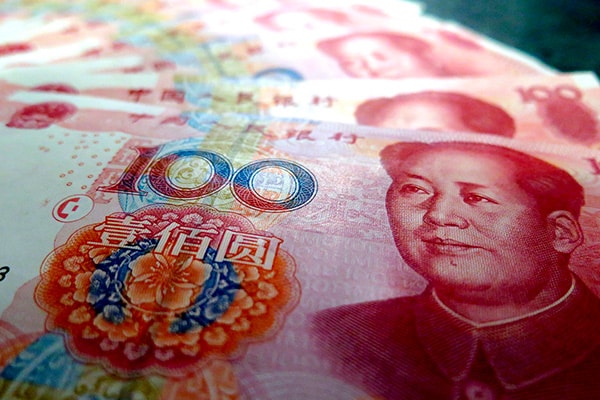Theme
This paper looks at the internationalisation of the renminbi in May 2018, why it has stagnated since 2015 and what its possible future course might be.
Summary
A Chinese proverb suggests that one should always be cautious and cross a river by testing the stepping-stones. It can be said that the Chinese authorities progressed fairly quickly in internationalising the renminbi between 2010 and 2015 remaining in fairly shallow waters close to the shore, but once they ventured into deeper and choppier waters (ie, the stock market turbulences of 2015) they realised their foreign exchange reserves were swiftly haemorrhaging and they decided to go back to a more active intervention in foreign exchange markets and to tighter capital controls. This slowed down the internationalisation process. The question now is whether the Chinese authorities will give up and withdraw or forge ahead. If the latter, conventional wisdom would suggest they follow a liberal course of action. But perhaps there is an illiberal option more suited to China’s state-led capitalism: in this alternative track the Belt and Road Initiative (BRI) can have the potential to provide the necessary stable footing to complete the endeavour the Chinese way. But it would be advisable not to wait with bated breath.
Analysis1
The motivations behind China’s internationalisation of its currency have become only too obvious in the aftermath of the global financial crisis of 2008-09. They can be summarised thus: (1) China wants a currency to match its economic status, since it is the world’s second biggest economy and the leader in purchasing power parity it wants its currency to be among the top ones; (2) it has realised with the crisis that it is too dependent on the US dollar, as made evident when Lehman Brothers collapsed in the autumn of 2008, when a dollar shortage spread throughout the world and economic activity plunged even in East Asia, the world’s most dynamic region; (3) by having an international currency, Chinese export and import companies can avoid exchange-rate risk, while firms and banks can invest all over the world in their own currency and, due to the demand for Chinese currency, foreign financing can therefore be cheaper; (4) it wants to develop its own financial centres in order to compete with New York and London, and while Hong Kong is already a top financial hub, Shanghai is not there yet and internationalisation will give it the boost it needs; and (5) many in China believe that for the renminbi (RMB) to be successful it will require certain structural, and difficult, reforms for China to continue benefitting from a sustainable growth.2
Since the Chinese government started in earnest to develop a two-track approach towards the RMB’s internationalisation in 2009, the currency has increased its level of foreign usage, with a steady rise from 2010 to 2013 and a substantial acceleration between 2013 and 2015. That year, the RMB even managed to be included in the Special Drawing Rights (SDR) basket of the International Monetary Fund (IMF), a milestone for policymakers in Beijing, especially at the People’s Bank of China (PBoC). However, since the stock market turbulences of 2015 and the depreciation of the RMB they provoked, the Chinese currency’s internationalisation in 2016 and 2017 either stagnated or even declined. In 2011, when first looking at the prospects for the RMB’s internationalisation, I argued that the Beijing authorities were following the traditional cautious Chinese approach of crossing the river by testing the stepping stones beneath the surface.3 In line with the same metaphor, it appears that they are now well into the river but that at the first sign of failing to find a firm footing they have taken a step back (ie, reintroducing capital controls and a more strictly managed exchange-rate regime) and are now wondering whether to continue or to move back.
Measuring the progress so far
Before entering into the question of whether China should continue to pursue its currency’s internationalisation and how it should do so, it is important to determine –as far as possible– what the foreign use of China’s currency is at present. Here it is useful to distinguish between sources, and between hard facts and rhetoric. Certain banks, like Standard Chartered, for instance, which is very active in emerging markets –including China– have an interest in overemphasising the rise of the RMB and underplaying its weaknesses,4 while certain academic authors, at the other extreme, can be too negative regarding the Chinese currency’s potential5. When looking at the data, however, there is a consensus that the internationalisation trend has stagnated since the RMB was included in the SDR. This can be seen graphically when looking at the curve of the Standard Chartered Renminbi Globalisation Index (RGI) (see Figure 1).6 On a more disaggregated level, here I use the usual functions of money as a medium of exchange (settlement, vehicle currency and swap lines), store of value (deposits, bonds and reserves) and unit of account (invoice and pegs) to provide an overall picture.7
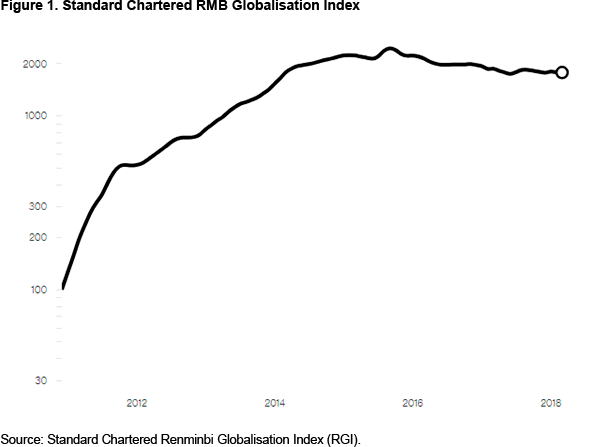
Starting with the medium of exchange function, China’s cross-border trade settled in RMB rose from over RMB500 billion in 2012 to RMB2 trillion in 2015 (its peak) to fall back to around RMB1 trillion in the spring of 2018 (see Figure 2). In percentage terms, this means that only 15% of Chinese trade is settled in RMB, and usually this includes trade with Hong Kong, which accounts for 80% of that trade. Thus, including Hong Kong as a national transaction, the share of Chinese trade settled, let along invoiced, in RMB would be very small.8 Where the RMB is regaining ground (almost reaching the levels of 2015) is in the settlement of China’s inward and outward foreign direct investment, and especially in the relatively newly established ‘Cross-border Interbank Payment System’, also known as China’s Interbank Payment System (CIPS), which is the Chinese equivalent of SWIFT and an important milestone in creating the necessary infrastructure to internationalise the RMB.
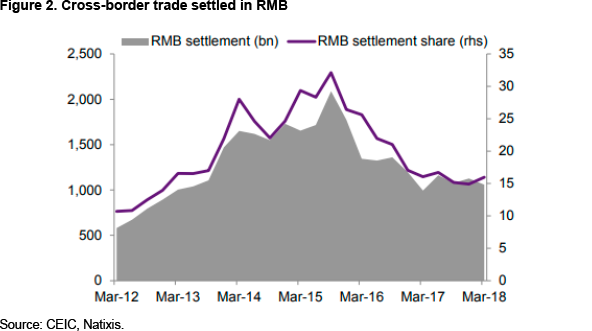
Finally, in this specific function of money there are also the official bilateral currency swap agreements that the PBoC has now signed with more than 30 other central banks (see Figure 3): the latest being Albania (in April 2018) and Nigeria (in May 2018). Here it is important to highlight that the total sum of the swaps has now reached RMB3 trillion and that the largest ones are with Hong Kong (RMB400 billion), South Korea (RMB360 billion) and the Bank of England and the ECB (at RMB350 billion each). However, so far only the Hong Kong Monetary Authority, and perhaps the central bank of Argentina, have used the facility. On the other hand, in 2014 China used its swap line with the central bank of Korea to obtain RMB400 million won for a Chinese commercial bank to provide trade financing for paying imports from Korea.9 Thus, there is a stark dissonance between the long list of swap agreements and their actual use.
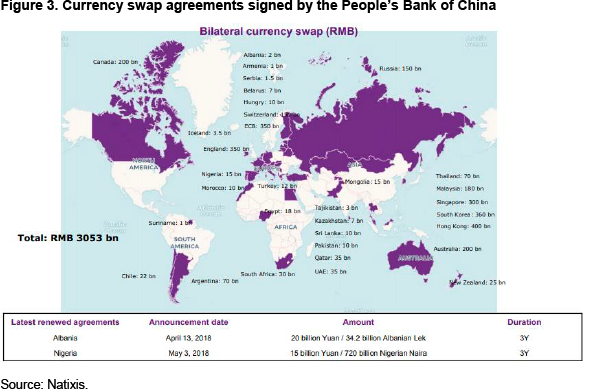
In the field of payment and vehicle currencies, the most reliable and quoted data are those provided by SWIFT for international payments, which show that the share of payments in RMB has shrunk from 1.60% in December 2015 to 0.98% in December 2017 (see Figure 4). This is far removed from the US dollar’s 41%, the euro’s 39%, sterling’s 4% and the yen’s 3.5%. As a matter of fact, the Chinese RMB is only in eighth position, after the Canadian dollar, the Swiss franc and the Australian dollar.10 In the foreign exchange markets the pattern is very similar. Here the essential data is the triennial Bank for International Settlements (BIS) survey that, in its latest edition, published at the end of 2016, shows that the US dollar comprises 88% of transactions (out of 200%, because there are always two currencies involved), the euro 31%, the yen 22%, sterling 13% and the Chinese RMB again in eighth position at 4%, in this case following the Australian (7%) and Canadian (5%) dollars and the Swiss franc (5%).11
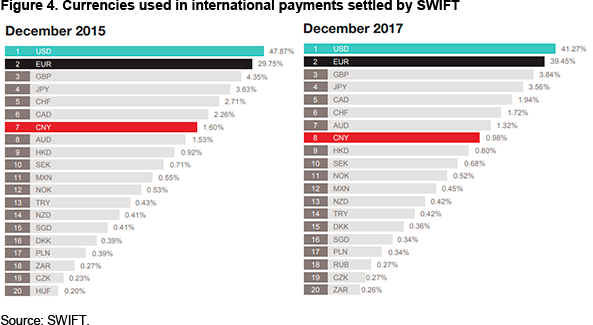
When it comes to the attribute of store-of-value, the RMB equity held by overseas institutions within China has overcome the slump of 2015 and 2016 and has now reached higher levels (over RMB1 trillion) than before the stock market turbulences of 2015. This shows that China’s stock-market connect initiatives12 are having some positive impact (see Figure 5). This can be said of private and public bonds in general, although here the preference is treasuries.
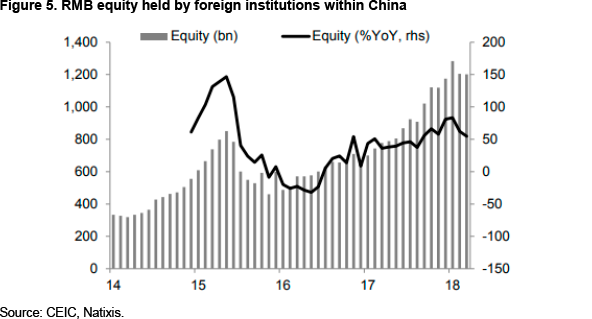
In this regard, it is interesting to see that in the RMB Qualified Foreign Institutional Investor (RQFII) quotas the countries that invest the most in China are the US, Korea and Singapore, followed by the UK, France and Germany. On the public side of the store-of-value function, the benchmark is the official foreign reserves disclosed by the IMF (COFER): again, the RMB is far removed from the other four currencies that compose the SDR basket, accounting for only 1% of allocated world reserves, while the US dollar is at 63%, the euro at 20% and both the yen and sterling at 5% (see Figure 6).
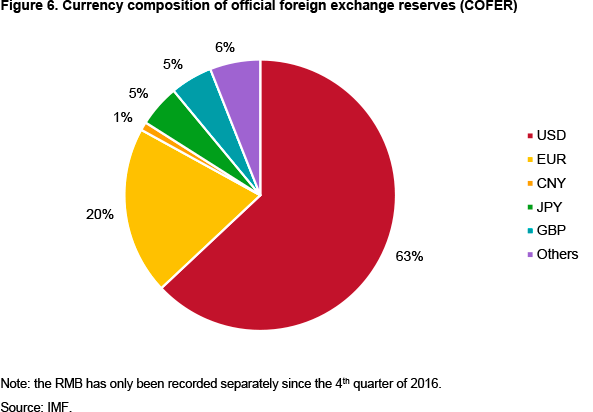
In the debt markets, the RMB is still in its infancy compared to the US dollar and the euro. The issue of private and public debt in foreign currency is so dominated by the US currency (60% of the total), with the euro a distant second (slightly more than 20%), that international comparisons usually only list the yen, below 5% and in decline, as is the trend for all other currencies.13 Nonetheless, from a very low base, corporate and sovereign bonds denominated in RMB have also overcome the dip recorded in 2015-16 and are now at record numbers, more so on the corporate side than the public one. Of course, here China and the RMB have enormous potential. Currently, the participation of foreign investors in the Chinese domestic bond market is only 2%, compared with 60% in Mexico and 35% in Brazil. This might change with the gradual opening up of the China Interbank Bond Market (CIBM), a development that international banks and investors are eagerly awaiting.14
On matters related to the unit-of-account function, the data are scant. In the EU, for instance, the data for extra-EU exports and imports of European firms show that roughly 50% of exports are invoiced in euros, around 30% in US dollars, 8% in non-euro European currencies and only 12% in other currencies.15 The Chinese authorities do not appear to provide this type of micro-data. Again, it is important to distinguish between the currency of invoice and that of settlement, which are not necessarily the same and determine exchange-rate risks. SWIFT offers data of RMB usage for commercial payments ending in China and Hong Kong and shows that a very high percentage of the purchases from countries such as the UAE, Korea and Taiwan are effected in RMB, with Korea close to 90%. The countries that use less RMB when purchasing from China are Pakistan and the US, doing so in less than 5% of payments. Countries like the Netherlands and the UK are in the middle, at close to 50% of payments in RMB. But it must be borne in mind that this is settlement and not invoice.
Of course, when it comes to invoice, the pricing of oil is a fundamental issue and in this respect China is making progress with the yuan-denominated crude oil futures contracts listed on the Shanghai Futures Exchange since 2018. If the market develops and, more importantly, if at some point the price of the oil barrel is quoted in RMB in any of the international markets, then this would be a game-changer. None of the other SDR basket currencies has that.
Explaining stagnation
This section aims to explain the reasons that brought the attempt to internationalise the RMB in 2015 and 2016 to a halt. In other words, what prompted the Chinese authorities to check their attempt to cross the river? Obviously, stock market turbulence and the consequent depreciation of the RMB were a watershed. Although there is a general sense that the stock market crash of Summer 2015 was triggered by ultra-loose credit easing, a stock market bubble and the underlying reduction in the pace of GDP growth of the Chinese economy, it is important to analyse more in detail some of the mechanisms that caused the crisis and the reaction of the Chinese authorities to mitigate it, since it was these same actions that impeded the further internationalisation of the RMB.
For this, it is useful to summarise the work of Zhang Ming, one of the most respected economists in China.16 In his view, one cannot understand the crisis, and the evolution of the internationalisation process of the RMB for that matter, without looking at the foreign exchange value of the Chinese currency. During the years 2013 and 2014, the US dollar appreciated considerably. Specifically, the US dollar Index appreciated 13% from the end of 2012 until the end of 2014. At the same time, due to the managed floating exchange rate regime of the RMB its value remained relatively stable vis-à-vis the US currency over the period, appreciating only 2.6%. This meant that the Chinese currency appreciated considerably with respect to other currencies, especially the euro. In fact, Zhang does not consider this, but during the period the value of the European currency was important for several reasons. First, the US dollar Index is heavily determined by the euro, since it accounts for 58% of its value, and, secondly, the Eurozone economy as a whole is roughly the same size as that of China, is a bigger exporter and has a much higher per capita income and therefore a very important systemic impact for China, not least because it is the second largest export market for Chinese products after the US. Hence, a considerable appreciation of the RMB versus the euro has substantial effects and that is precisely what occurred between May 2014, when the ECB, under the command of Mario Draghi, accelerated its dovish monetary policy, and April 2015, just a few months before the stock market crash in China. In this period the RMB appreciated a whopping 25% against the euro (see Figure 7).
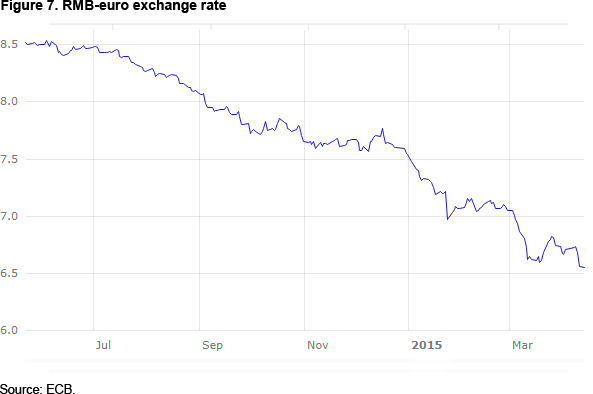
This massive appreciation of the RMB led Zhang to argue that the RMB was overvalued over the period according to macroeconomic fundamentals and therefore that at some point the market expectations of an ever appreciating RMB, which drove RMB internationalisation, would have to be reversed, and this happened over the 2014 and 2015 period. Interestingly, for more than a year, from February 2014 until April 2015, the PBoC intervened in the FX market to keep the exchange rate of the RMB stable vis-à-vis the US, but by doing so the value of the Chinese currency was increasing versus the second most international currency: the euro. This was highly problematic and partly explains, alongside the bleeding of reserves that the intervention was generating, why finally the PBoC decided on 11 August 2015 to reform the exchange rate mechanism and let the RMB depreciate more on a daily basis. Actually, Zhang points out that the ‘RMB exchange rate mechanism entered the era of free floating during a short period after the 8/11 reform… (since) the opening price of RMB against the US$ decreased from 6.1162 on 10 August 2015 to 6.4010 on 13 August 2015, depreciating 4.7% in only three days’. In the metaphor employed above, this is the moment when Chinese policymakers, in their journey across the river of internationalisation, realised that they could not see the next stepping stone, and they quickly drew back. They intensified intervention in the foreign exchange market and tightened capital controls.
Overall, in order to stem the crisis, the Chinese authorities applied three strategies that might have been necessary to avoid further instability but all of them were detrimental for the internationalisation of the Chinese currency. First of all, they had to use their massive foreign exchange reserves to keep the value of the RMB stable. This came at a cost. Chinese foreign reserves declined from US$4 trillion in June 2014 to US$3 trillion in January 2017 (see Figure 8), a massive reduction that came very close to what many in China believed would be the optimal level of reserves: according to Zhang’s own calculations, following the IMF matrix, this was US$2.83 trillion by the end of 2016. The massive reduction in reserves dented China’s prestige as a stable economy and therefore discouraged the holding of RMB abroad. In hindsight, however, as in the 1997-98 Asian Financial Crisis, international observers might value the fact that the Chinese authorities kept the exchange rate stable. At that time many in the West feared that China would let its currency drop by 20% and that it would lead to a massive deflationary shock in the world economy and intensify the pending currency wars.
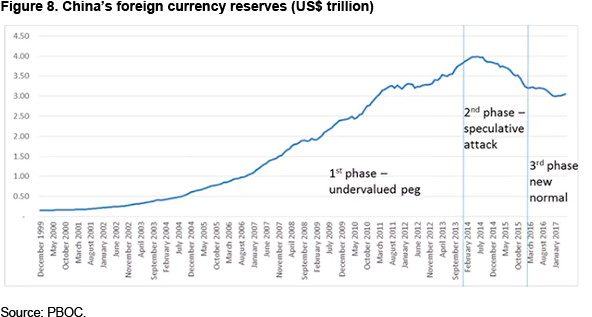
Since the foreign exchange intervention was not very effective, the Chinese authorities had to use more drastic measures to halt the haemorrhage. This they did in the form of tighter capital controls. In particular, Beijing started to worry that much outward foreign direct investment (OFDI) was not really that, but rather capital flight. For that reason it first started to restrict OFDI in foreign currencies (to ensure RMB internationalisation was unaffected) but then also in RMB, which, of course, massively reduced the access to RMB overseas. Zhang reckons that the PBoC strategy was effective. ‘After 11 consecutive quarters of financial account deficit from 2014Q2 to 2016Q4, China began to face 4 consecutive quarters of financial account surplus from 2017Q1 to 2017Q4’. But stopping in mid-river had two major consequences. First, the liberalisation of the capital account, envisioned by the PBoC to reform the country and put it on a more sustainable course of growth, was reversed, and, secondly, that the offshore RMB markets dried up. One thing is clear, if the RMB wants to become an international currency, foreign investors need to get hold of it and this can only happen via a current or capital account deficit: this is a major structural issue that China still needs to overcome.
Most Western (and even Chinese) experts and commentators would also argue that for the RMB to be a fully international currency its price needs to be determined by market forces, as with the US dollar, euro, sterling and almost always for the yen. This is not the case with the RMB, and certainly not since the 11/8 reforms. Free floating was considered a no-go by the Chinese authorities and from the end of 2015 and early 2016 they introduced a series of changes that reduced rather than liberalised the RMB’s market pricing. The first was the introduction of the China Foreign Exchange Trade System (CFETS), which essentially tracks the value of 13 currencies on a weighted basis with the US dollar as its largest component (26%), followed by the euro (21%), the yen (15%) and so forth. The RMB’s price therefore follows two variables, each with a weight of 50%: the closing price of the previous day in the FX market and the CFETS exchange rate. The arrangement was not, however, optimal. When the US dollar index weakened (and hence the dollar depreciated) the RMB vs the US dollar exchange rate remained relatively stable, but when the US dollar index climbed the depreciation pressure on the RMB multiplied, undermining the entire object of the exercise. This led in May 2017 to the introduction of the ‘three-factor pricing mechanism’, which includes the two variables mentioned above and a ‘counter-cyclical adjustment’ factor, which essentially means that the PBoC will intervene whenever it thinks that the price of the RMB is misaligned with macroeconomic fundamentals and follows market irrationality. This is in line with the usual Chinese government tradition of generating ‘administratively managed market equilibria’.17 The ‘three factors pricing mechanism’ has so far worked, but the drawback is that RMB exchange-rate liberalisation was postponed indefinitely.
Overall, it can be concluded, as Zhang & Zhang do in another worthwhile study,18 that between 2010 and 2014 the remarkable success in the RMB’s internationalisation was to a large extent driven by market expectations of an appreciation and the consequent arbitrage the trend gave rise to, rather than on any solid grounding. The Chinese authorities continued to cross the river but at some point they realised their footing was unsure, as suggested by those critical of the inclusion of the RMB in the SDR basket of the IMF.19
The way forward
Now that RMB internationalisation is stuck in mid-river, perhaps many in China are thinking that it was not a good idea to begin to cross in the first place. There is a reason why Germany and Japan, two other large export countries, were always reluctant to internationalise their currencies. It is also true that the timing of internationalisation is a key factor. Japan started the process late and it did not work.20 But in normal circumstances –given its size, untapped potential and growth trajectory– there is no reason to believe that China cannot have an international currency with at least as much international market share as the euro has today. The question is: what steps should it now take? Conventional wisdom is that China needs to further liberalise its economy and financial markets.21 This is the ‘liberal’ approach dominant among Western commentators, and also among renowned economists in China. Zhang & Zhang follow this way of thinking and propose a number of reforms to achieve what they call a ‘more sustainable RMB internationalisation in the future’.
First, they suggest that China needs to continue to generate high and efficient growth, but for that to happen and to overcome the headwinds of aging, a diminishing yield of capital investment and the slowing down of total factor productivity growth, the Chinese authorities need to break up the monopoly of state-owned enterprises (SOEs), promote private entrepreneurship, liberalise domestic factor prices and improve income redistribution. Secondly, they warn that the government needs to develop and apply a more robust counter-cyclical macro-prudential policy framework to avoid a systemic banking crisis. This means that it needs to apply more market-oriented measures to deal with non-performing loans and clean up the balance sheets of banks. Third, the liberalisation of the capital account should only be gradual and once three conditions are met: (1) the full liberalisation of RMB interest rates; (2) the liberalisation of the RMB exchange rate; and (3), most importantly, opening the capital account gradually and only after the vulnerabilities in the financial system are overcome. The fourth reform, a proposal linked to (3) above, is to develop China’s financial markets. In the Zhang’s words, ‘ultimately, the competitiveness of a currency is determined by the development and openness of the domestic financial markets’.22 In particular, they say that China needs to augment its corporate and sovereign bond markets. Finally, they propose that the Chinese authorities should focus their efforts in the region. ‘In the future, more real demand for the RMB would come from Asian countries, not remote European or American countries, considering the current distribution of global production networks’. In other words, before becoming an international currency, the RMB needs to become the regional currency, starting within the ASEAN+323 framework.
This is the logically liberal path to attempt to cross the river; but is it the only one? Other authors, more in the international political economy tradition, have argued that in a less liberal world, and that may well be the case in the coming century, perhaps the main international currencies might not be issued by liberal regimes.24 In this respect, political stability, sought by international investors, might not necessarily be provided by the rule of law, plural democracy and a market economy. A more illiberal, less financial-led socio-economic framework might be equally attractive, as long as the issuing country maintains other key determinants for currency internationalisation such as a large economy, a stable macroeconomic framework and enhanced network externalities. China is already the largest trading partner for a great number of countries, and the long list of currency swap agreements between the PBoC and other central banks shows that there is both interest in and demand for good monetary relationships with the Middle Kingdom. Nonetheless, this does not avoid the structural determinant, which is that China needs to provide the world with RMB either by running a sufficiently large current-account deficit, like the US does today (but something China is reluctant to do), or a financial account deficit, which the Chinese authorities have just shown they are not that keen on either.
It is here where the Belt and Road Initiative (BRI) comes into play. The BRI is certainly the most ambitious and, for many, the most exciting foreign affairs and geopolitical project witnessed over the past few decades. The sheer size of the endeavour, with trillions of dollars to be invested in infrastructure in railroad, ports, roads, pipelines and fibre optic, is mindboggling. Many believe it is over-ambitious because it tries to connect the two ends of the Eurasian supercontinent with regions that are highly unstable. There is also the question whether most of the benefits and contracts will go to Chinese companies and leave many countries over-indebted. But China seems to be serious about the endeavour. The economic corridor in Pakistan and the creation of the Asian Infrastructure Investment Bank (AIIB) are perhaps the two most significant developments in the BRI. It is clear that for its economic size China still has very low OFDI and this will only increase in the future. This is already noted in Europe, where the debate about receiving more Chinese investment has become a hot topic in policymaking circles. Many see a danger in the rise of China, but others see great opportunities.25
As noted by a joint cooperation effort by researchers from Chatham House and the Institute of World Economics and Politics (IWEP) at the Chinese Academy of Social Sciences, European and Chinese actors can collaborate in the success of the BRI and the parallel internationalisation of the RMB.26 The example of the management of the AIIB, in which the Europeans are highly involved, can be a small laboratory in this regard. Much of the financing of the BRI, which attempts to be a public-private endeavour, is channelled through financial centres such as London and Frankfurt and Paris by issuing RMB-denominated bonds, for instance. In principle, much of the financing infrastructure needed for BRI to be successful, from bonds to loans to development aid, could be invoiced and settled in RMB. But for this to happen, the Chinese government would need to take the initiative and convince key actors in Asia, Europe and beyond, about the benefits of such a change. Here market inertia provides a strong headwind. Furthermore, if the RMBs gained abroad cannot be invested in China, it will always be difficult for the Chinese currency to be attractive. But the journey is long and China’s interbank payment system (CIPS) is a start in creating the necessary infrastructure for the RMB to be more attractive. However, so far even the China-led AIIB has rejected the idea of operating in RMB. Hence, doubts remain about the next steps to be taken in the RMB’s internationalisation.
Conclusions
From the start, Beijing adopted the traditional and cautious Chinese approach of crossing a river by testing the stepping stones when it came to internationalising the RMB. As in crossing any river, the first few steps were easy. RMB internationalisation, from a very low starting point, progressed exponentially, so much so that there was speculation that China would at some point liberalise interest and exchange rates and fully open up its capital account. But once internationalisation stepped into deeper waters, the currents became stronger and the stepping stones more unsure. After moving towards appreciation alongside the US dollar between 2012 and 2015, market expectations started to change and a market panic broke out in the summer of 2015. After haemorrhaging reserves during a year, the Chinese authorities realised there was no stepping stone underfoot when they let the currency float on 11 August 2015. This was the watershed that let them halt in mid-river and reapply stringent FX interventions and capital controls.
Currency internationalisation comes with benefits, as explained in the introduction, but also with costs and burdens, especially if it is achieved via liberalisation: (1) the Chinese authorities took control over their currency’s capital and exchange rate movements; (2) they relinquished the macroeconomy levers over which they now keep a tight control, especially as regards steering the credit cycle; (3) the Chinese economy was far more at risk of potential foreign speculative attacks; (4) the central bank was under considerable scrutiny to stabilise the financial system without the control it now possesses; and (5) China would need to be a much more active player, with more responsibility, in stabilising and governing the international monetary system. All this can be frightening and some can be tempted to draw back.
Thus, there are now three possible ways forward for the Chinese currency: (1) China can give up on RMB internationalisation and step back; (2) it can follow the liberal course of developing its financial markets, becoming a market economy and liberalising its exchange rate system, thus opening its capital account; or (3) refuse to follow a liberal course and continue on an illiberal footing by keeping its domestic market relatively state-managed and, on the basis of its Belt and Road Initiative, start to actively promote the RMB as the invoice and settlement currency for most transactions. The latter would mean that China would still be in relative control on how and where the RMB flows out (specific projects and loans) and how and where it comes in (what can be sold to China and where it can be invested). Such a state-led international command-and-control framework has not existed since at least the Middle Ages as regards international currencies but, in an ever-changing world in which liberal forces are retreating, the possibility cannot be completely ruled out.
Miguel Otero-Iglesias
Senior Analyst for International Political Economy, Elcano Royal Institute, and Professor, IE School of International Relations | @miotei
1 Paper presented at the Forum ‘China’s innovation development and global economy’, organised by the Chinese Academy of Sciences and the Fairbank Center for Chinese Studies at Harvard University and the Lee Kuan Yew School of Public Policy at the National University of Singapore, Beijing, 21-22/V/2018. The author would like to express his gratitude to Elsa Carrasco for her research assistance.
2 Ming Zhang & Bin Zhang (2017), ‘The boom and the bust of the RMB’s internationalization: a perspective from cross border arbitrage’, Asian Economic Policy Review, vol. 12, nr 2, p. 237-53.
3 Miguel Otero-Iglesias (2011), ‘The internationalisation of the renminbi: prospects and risks’, ARI, nr 73/2011, Elcano Royal Institute, 18/IV/2011.
4 Standard Chartered Bank (2017), ‘RMB internationalisation in 2017: change, alignment and maturity’, Hong Kong.
5 J. Benjamin Cohen (2017), ‘Should China be ejected from the SDR?’, Project Syndicate, 30/V/2017.
6 Renminbi tracker: How global is the renminbi?, Standard Chartered.
7 Most of the data is drawn from the very useful Natixis RMB Internationalisation Monitor of May 2018 by Alicia Garcia Herrero and her team.
8 The distinction between invoice and settlement is important because if a Chinese export or import company settles in RMB but invoices in US dollars, it carries the exchange rate risk.
9 There is a very useful interactive webpage on Central Bank Currency Swaps by the Council on Foreign Relations. Updated in February 2018.
10 SWIFT (2018), ‘RMB internationalisation: where we are and what we can expect in 2018’, RMB Tracker, January.
11 BIS (2016), ‘Turnover of OTC foreign exchange instruments, by currency’, April.
12 ‘Stock Connect’ refers to the link between the stock exchanges of Shanghai and Shenzen with Hong Kong. See Goldman Sachs (2016), ‘What is stock connect’, December.
13 ECB (2017), ‘The international role of the euro’, July.
14 See the 2017 Standard Chartered report on the RMB mentioned above.
15 Eurostat (2017), ‘International trade in goods by invoicing currency’.
16 Ming Zhang (2018), ‘China’s efforts to contain renminbi’s depreciation and the relating impacts’, paper presented at the seminar Chinese Overseas Investment in the Energy Sector: Opportunity and Risk, organised by the Global Development Policy Center of Boston University and the Institute of World Economics and Politics at the Chinese Academy of Social Sciences in Boston, 30/III/2018.
17 Miguel Otero-Iglesias & Mattias Vermeiren (2015), ‘China’s state-permeated market economy and its constraints to the internationalization of the renminbi’, International Politics, vol. 52, nr 6.
18 Zhang & Zhang (2017), op. cit.
19 Miguel Otero-Iglesias (2016), ‘The institutional limits to the internationalisation of the RMB’, Financial Times, 15/I/2016.
20 For a more recent take see N. Saori Katada (2018), ‘Can China internationalize the RMB? Lessons from Japan’, Foreign Affairs, 1/I/2018.
21 For a recent short review, see Barry Eichengreen (2017), ‘The renminbi goes global: the meaning of China’s money’, Foreign Affairs, 13/II/2017.
22 Zhang & Zhang (2017), op. cit., p. 250.
23 ASEAN+3 refers here to the 10 ASEAN countries and China, Japan and Korea.
24 See Jonathan Kirshner (2014), American Power after the Financial Crisis, Cornell University Press, Ithaca; and Christopher A. McNally & Julian Gruin (2017), ‘A novel pathway to power? Contestation and adaptation in China’s internationalization of the RMB’, Review of International Political Economy, vol. 24, nr 4, p. 599-628.
25 John Seaman et al. (2017), ‘Chinese investment in Europe’, ETNC Report.
26 Paola Subacchi et al. (2017), ‘The Belt and Road Initiative and the London market – the next steps in renminbi internationalization’, Chatham House papers.
